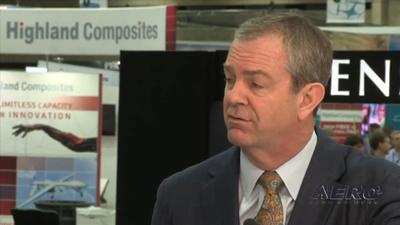But Public Acceptance Is Key, Speakers Say At AUVSI
As AUVSI president and CEO Brian Wynne introduced Tuesday’s keynote speakers at Xponential 2019, he first pointed out that the biggest challenges facing the professionals in the audience involve convincing a generally skeptical public that the new technologies they are fostering will improve their quality of life.

Wynne (pictured) called for “complete agreement that the number one thing we need to work on is pubic acceptance.”
With that, speakers with divergent backgrounds expounded on how unmanned technology is fostering a cultural revolution of sorts, which is changing nearly every aspect of human existence and will continue to do so.
Two industry leaders, Precision Hawk CEO Michael Chasen and Florida Power and Light’s drone-program chief Eric Schwartz, together addressed how drones are incorporating artificial intelligence (AI) to monitor the company’s vast network of power equipment.
Before Chasen and Schwartz spoke, journalist and screenwriter Dan Lyons marveled about the changes unmanned technology has brought forth within a mere handful of years. He also offered words of caution to companies that would choose to champion unmanned and AI systems at the expense of their human employees.
Think of the stupidest person you know, Lyons told the audience. “That person can drive a car,” Lyons said. “The smartest robot cannot.”
Lyons pointed to a graphic takeoff on DaVinci’s Creation, which showed a robotic Hand of God reaching down to a human one. “I want to talk about the interface — the place where those two fingers are meeting,” he said.
Lyons pointed out that despite the “miracles” that are emerging with the advent of automation and the internet, studies show that “people are more miserable than ever before.” He mentioned empirical evidence that people fear they will lose their jobs to robots – or, perhaps equally as bad, be forced to assume workplace subservience to AI computers and automatons.
“Today, a lot of people go to work and feel like technology uses them. The effect is people feel dehumanized,” Lyons said.
He offered three pieces of advice:
- Don’t sleep in your moving Tesla. Overconfidence in the emerging technologies would likely do more harm than good.
- Change, but slowly. “Humans can’t change as fast as machines, and as fast as we want them to.”
- Invest in your humans. “Pay them better. Provide them with benefits. Invest in training and development.” Companies that take this approach, he said, outperform those who do not.
Before introducing Schwartz, Chasen talked of the key roles AI and machine learning are already playing in the industry. He believes the two factors are about to trigger the transition to exponential growth from merely strong growth.
“I can tell you it’s happening in multiple industries,” Chasen said. “It’s starting to change the way businesses look at their operations.”
Schwartz discussed how Florida Power and Light and NextEra Energy, Inc., are using AI and machine learning to improve reliability for their customers. Florida Power and Light employs 3,000 people and maintains 75,000 miles of power lines and 890,000 transformers in the state alone. NextEra, which owns FP&L, operates in states outside of Florida as well as in Canada and other nations.
The parent company is the “world’s largest generator of renewable energy,” Schwartz said.
Today, FP&L employees are “literally driving and walking every mile of every feeder … using their subjective experience” to identify potential problems.
The company believes that AI and machine learning could assume that burden and perform it more efficiently, Schwartz said.
Hurricane Irma, which struck Florida in 2017, proved his point, he believes. The Federal Aviation Administration granted 51 emergency certificates of authorization, allowing the company to conduct unmanned flights over affected equipment. The COAs helped FP&L restore service more quickly, and expand use once normalcy resumed. Last year, Schwartz said, the company was able to inspect 4,000 miles of equipment autonomously. “This year, we’ll be able to reach well over 10,000 miles,” Schwartz said.
(Source: AUVSI news release. Image from file)
 Airborne-Flight Training 05.09.24: ERAU at AIAA, LIFT Diamond Buy, Epic A&P
Airborne-Flight Training 05.09.24: ERAU at AIAA, LIFT Diamond Buy, Epic A&P ANN's Daily Aero-Term (05.07.24): Hazardous Weather Information
ANN's Daily Aero-Term (05.07.24): Hazardous Weather Information Aero-News: Quote of the Day (05.07.24)
Aero-News: Quote of the Day (05.07.24) NTSB Final Report: Cessna 150
NTSB Final Report: Cessna 150 Aero-News: Quote of the Day (05.08.24)
Aero-News: Quote of the Day (05.08.24)



